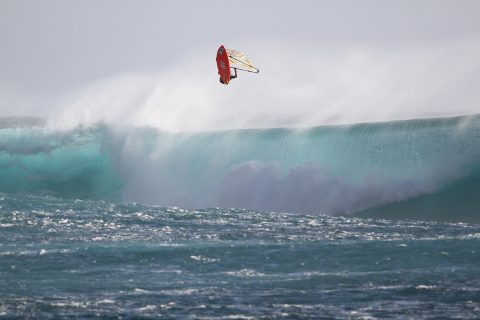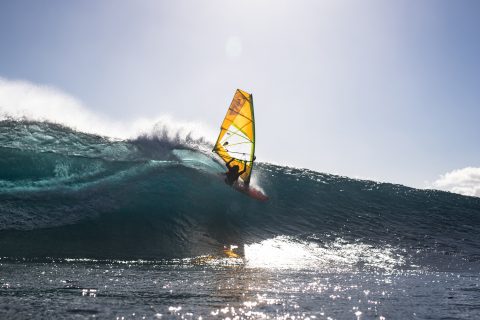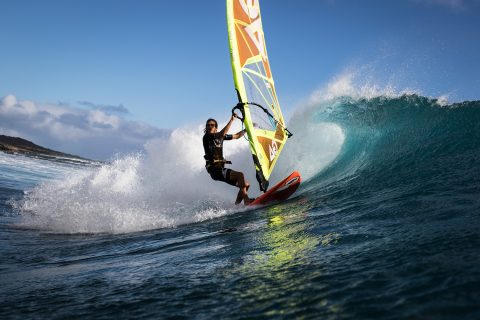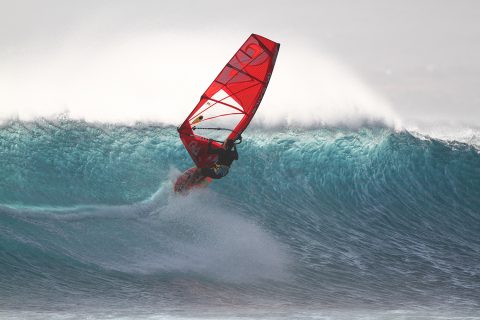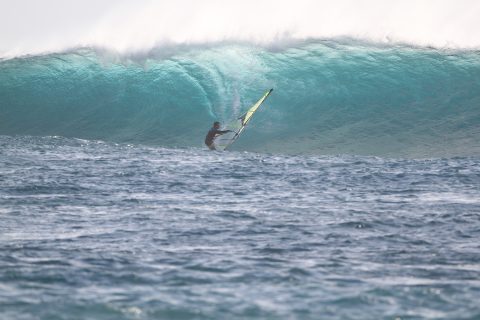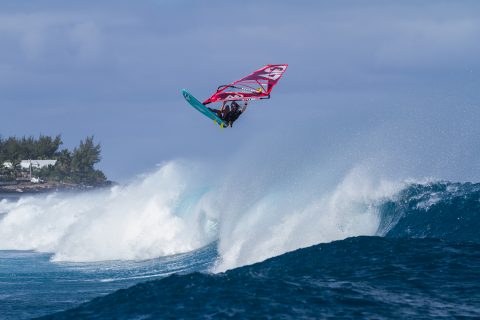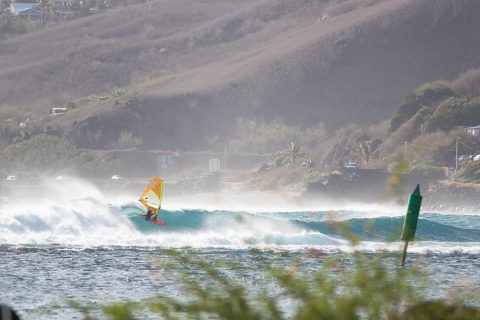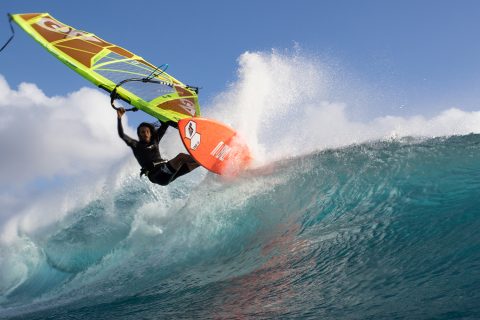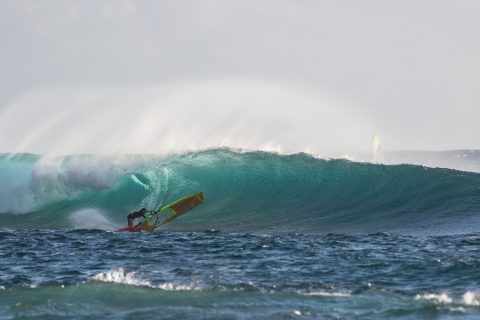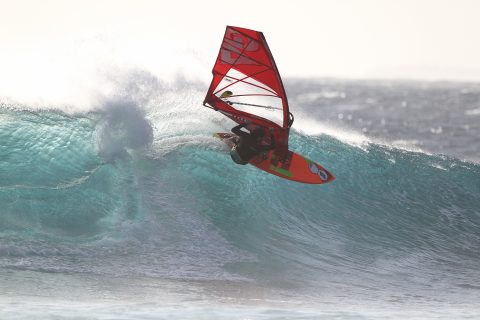THOMAS TRAVERSA: LA REUNION
Thomas Traversa made a welcome return to Réunion Island for a strike mission last summer, keen to score some waves when travel was permitted. From our September issue of Windsurf Magazine, Thomas reflects on his trip, casting his worldly eye on the changes in travel and watersports on the island since his last visit ten years ago. We have also added his guided tour videos from the same trip!
WORDS – Thomas Traversa // PHOTOS – Armand Daydé and Charly Bell.
In 2021, is it possible to write a travel story without mentioning the Covid-19 crisis? I don’t think so. Is it simply possible to go on a trip? More or less, not really, kind of, but certainly not as before.
- Big air from Tommy T
Let’s take a look at the situation. In July 2020, as a French citizen I regained the right to move freely in my own country, and European countries had just reopened their intra-community borders. Outside of the European Union, traffic remained very complicated, and countries like Australia had even announced that they wanted to keep their borders closed until 2021… one year later we can’t really say that situation has got much better.
- Thomas carving on a sublime wave
If France no longer has the cultural, philosophical, artistic and scientific grandeur that it may have had in the past, it has been able to retain many assets from its former colonial empire: a real expertise in the manufacture and sale of military weapons, a powerful army present in the majority of armed conflicts, a certain political influence in North and West Africa and powerful oil companies.
France has also retained control of vast maritime areas in various oceans, and still possesses many islands in Polynesia, the Caribbean and the southern seas, not to mention the Indian Ocean.
- Ready to strike
FRENCH HAWAII.
This leads us to the island of Réunion, a region of France, not far from Madagascar and very close to Mauritius. Formed by a huge active volcano, the Piton de la Fournaise, and another volcano, the Piton des Neiges, which tops out at more than 3000 metres. Reunion strangely resembles the Hawaiian Islands. A wet, green and relatively wild east coast, a drier, more populated southwest coast, lined with coral reefs. Constant trade winds and powerful southern swells during the southern winter (our summer in Europe) make this island a paradise for surfers and windsurfers, a real French Hawaii.
I had already been to Reunion in 2004, then in 2009 and 2010 for the “Reunion Wave Classic” contest. Given the travel limitations due to Covid-19, it seemed obvious to me that it was the only place where I could score world-class windsurfing conditions in the middle of July. I had always wanted to come back to this island, but never had the time to do so, because of the PWA competitions, my family life ….and the sharks.
- Thomas Traversa goes up and under!
LOGISTICS
Mandatory Covid-19 screening test within 72 hours before takeoff, an almost deserted Marseille airport, a somewhat sinister atmosphere at a barely less deserted Paris CDG airport, face masks, body temperature tests, some people wearing sterile suits, a feeling of general malaise, a half-empty plane, a service on board limited to a minimal crew, suspicious looks at the slightest sneeze and masks again. On arrival an endless queue to leave the lobby, a short individual interview with a doctor for each passenger, then finally the open air, the morning freshness of the southern winter, the smells of tropical plants, the volcano that dominates everything, the ocean, the people, life. The mask can be removed.
- One arm and one leg and still charging
SHARKS
In 2021, is it possible to write something about Réunion Island without mentioning the shark crisis? I don’t think so.
Is it simply possible to surf and windsurf? More or less, not really, kind of, but certainly not as before.
Over the last ten years, a large number of shark attacks have taken place on the Réunion coast. Attacks on bathers, and on surfers. Serious, often fatal, attacks. The “shark risk” quickly became “shark crisis”, and swimming and surfing were banned. Sharks have been caught, tagged, studied, killed, and culprits identified: bulldog sharks and tiger sharks. We have looked for explanations, causes and solutions. This divided the population – those who wanted to leave the sea to sharks and those who wanted to eliminate them. Between the two a majority of people who simply wanted to be able to enjoy the ocean without being devoured at any time.
- Thomas flying high in Reunion Island
A government plan was decided; some beaches have been protected, and elsewhere access to the sea has been prohibited. Windsurfing has never really been banned, but some have stopped, many have reduced their practice, preferring to go to Mauritius or Madagascar to sail a week or two in the year. Most surfers stopped surfing, a few continued despite the risk and prohibitions, adapting: rarely alone, never after 2 p.m., as it is always after 2 p.m. that large sharks equipped with trackers approach beaches and surf spots. Never when the water is blurry, almost always equipped with electric devices as “Shark Shield”, “NoShark” etc … whose effectiveness is not 100% proven. But so far no surfer wearing one of these devices has been attacked…
All this I learned once I was there, because I had not really followed what was happening in detail. I only knew that sharks were attacking, that people died, that the population was afraid and angry, and that surfing was forbidden. I also knew that no windsurfer had been attacked for a very long time, and on my Facebook feed I regularly saw images of my friends on Reunion windsurfing on perfect waves.
- Perfect waves in La Reunion
EXCEPTIONAL
My trip lasted only 7 days, because the weather forecast was exceptional and I thought that the less time I stayed, the less chance of being attacked by a shark! Welcomed like a king at a friend’s house, I think I can say without exaggeration that this trip offered me the best 7 days in a row of windsurfing in my entire life. On the day I landed I was able to enjoy a dream session at the spot of Saint-Leu, accompanied by 2 local windsurfers and a kitesurfer. During my previous 3 visits I had never had the chance to sail on this wave that made the reputation of the island in the world of surfing, and was zealously protected by local surfers. The following days, I sailed every morning on the incredible wave of Etang-Salé, alone or with a few locals. This spot is just perfect, the wave wraps around a coral reef, and ends up forming a big bowl before dying in deeper waters, a hundred metres from a large black sand beach where the locals like to come picnic, play ball, or just enjoy the seaside.
PURE PLEASURE
At each session, the same feelings of gratitude for these magnificent waves, the same large smiles exchanged on the water, and on the beach. Pure pleasure. In the afternoon, I go back to Saint-Leu or Pointe au Sel, another dream spot: a very fast wave, very hollow, very beautiful … which ends up in a closeout on a gnarly shallow reef. Again, very good times spent on the beach with the locals, delighted to share their spot with me. I am offered tea, and hang out and chat in the parking lot after the session.
- Thmas goes eye to eye with his courageous water photographer Armand Daydé
SAINT-LEU
On the fifth day, I go to Saint-Leu for the afternoon session, the wind is light, but the waves are sublime and there is a windsurfer in the water. I join him, accompanied by Armand who follows me and has been taking pictures of me from the start of my trip: sometimes from land or from his small boat, and also in the water when conditions allow. I asked him if he was afraid to swim 2 hours at the peak with his camera, he tells me that he isn‘t, I trust him. After riding my first wave, I go back out to sea and watch the other windsurfer draw a superb turn in the bowl. Then he comes out of the wave, and I realize that he is missing a forearm and that he also has a prosthetic leg! While I have been living a sort of a dream for a few days, I am suddenly caught up by the reality of the shark risk. Armand tells me that he knows him, his name is Fabien, he is an excellent surfer and windsurfer who lost his two limbs during an attack while he was surfing at this very spot in the early 2010s. I can’t help but admire his attitude, and his level. A surfer joins us at the peak on his longboard; his nickname is “clean head”, another real local of the spot. As I say hello, he tells me that he is very happy to share these superb conditions, and these “good vibes”. The sun begins to drop, meaning it’s time for us to all leave the water, and “clean head” comes to chat with me on the beach… and leaves me to think of the times before the shark crisis, when the locals had the reputation of being aggressive, even violent, with tourists.
- Another wave another bottom turn in the pit
RISKY BUSINESS
The next day, I do a short session in Pointe au Sel in the morning, then I decide to go sailing at Étang-Salé to enjoy the new powerful swell that is arriving. The sky is grey and the wind is very light. Armand films me from the land and for the first time since the beginning of my trip I tell myself that I am taking too many risks… it’s 4 p.m., the wind completely dies, but I manage to catch a last wave. I fall on the last section and my equipment is drifting towards the exit of the small lagoon. While I swim I try to keep my composure, but I keep telling myself that I’m stupid, that maybe I’m going to get bitten because of a failed aerial when I should have gone in as soon as possible. I finally reach my equipment, and spend the next 15 minutes floating as best I can on my board, without any wind. Drifting slowly, doing everything I can to reach the beach, which is only 100 metres away, but seems so far.
- Another beauiful wave ride from Traversa
WHAT A TRIP
As you read this, you can guess that I made it back safely! On the last day of my trip I scored a truly epic session at Pointe au Sel, with strong winds and some very large sets. We had a goodbye party with the locals, and I flew back home the next morning, thinking I would go back again in 2021. It has not happened yet, and I am not sure it will be possible. But what a trip it was!

